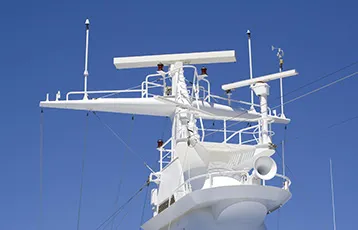Remote radio survey has been implemented since October 2018 and is a cost-effective way of staying in compliance. The remote survey process is however slightly different from traditional radio survey. This statutory news summarizes the main issues to be aware of when considering a remote radio survey.
Relevant for ship owners and managers, suppliers and flag states.
General procedures for radio surveys
To conduct a traditional radio survey on board DNV GL classed vessels, the owners of the vessel shall contact a DNV GL approved radio service supplier (‘supplier’ hereafter) who shall then assign a qualified radio inspector (‘inspector’ hereafter) for the task. The owners must request the radio survey through MyServices on Veracity before the radio survey begins and inform DNV GL about the supplier’s/inspector’s contact information. Thereafter a DNV GL attending surveyor is appointed and assigned the tasks to exchange relevant information with the inspector, provide current survey reports, follow up the survey results, and issue relevant certificate and statements. The inspector must contact the DNV GL attending surveyor before the start of the radio survey.
Procedure for remote radio survey
As an alternative to the normal procedure, remote radio survey has been implemented since October 2018 and may be offered to DNV GL classed vessels in cases where the radio survey does not coincide with other surveys which require attendance of a DNV GL surveyor.
If remote radio survey is an option, this will be prompted when submitting the survey request. The remote survey will be confirmed by DNV GL, and the job will be assigned to a DNV GL remote surveyor (‘remote surveyor’ hereafter) who will be responsible for coordinating the radio survey. The owners of the vessel and the supplier/inspector conducting the survey shall contact the remote surveyor instead of an attending DNV GL local surveyor before the start of the radio survey.
For DNV GL to credit the results of the radio survey without delays, owners/managers and the supplier/inspector must always contact the assigned DNV GL remote surveyor well in advance of the planned radio survey. Guidance on how to ensure that DNV GL receives the required information in time is summarised below.
Owner/manager’s responsibilities:
If a remote radio survey is requested instead of a normal radio survey, the owners are asked to initiate a remote radio survey request in Veracity and confirm/provide the following:
- PLACE/DATE/TIME of the radio survey.
- The contact details of the supplier (must be DNV GL certified as found in DNV GL Approval Finder Portal; see link below).
- Name and contact details (mobile number/email) of the inspector.
- Inform the approved supplier/inspector to contact the assigned remote surveyor at least 24 hours before attending the vessel, and when on board.
- Master’s statement confirming that radio equipment is free of known deficiencies.
- Information about any delays or transfer of the radio survey to another time zone for DNV GL to be able to assign the task to another remote surveyor.
- After conclusion of the radio survey: Master’s endorsement of the survey results and confirmation that the radio inspector was not involved in any reprogramming, repair, commissioning, and/or installation of the GMDSS installation before, during, or after the radio survey.
Failure to follow the above may result in DNV GL not crediting the radio survey remotely.
Radio service supplier/radio inspector’s responsibilities:
When a supplier is hired by an owner or manager to conduct a remote radio survey, the supplier shall assign a qualified inspector for the task. The inspector assigned to conduct the survey shall always:
- Contact the DNV GL remote surveyor as soon as possible and preferably at least 24 hours before attending the vessel to:
a. Confirm the exact time of the survey, and
b. Obtain all relevant flag and class related information/ forms, and
c. Agree with the remote surveyor on further follow-up during and after the survey. - Contact the remote surveyor when arriving on board to confirm the start of the survey.
- Report to the remote surveyor about possible findings, observations, changes to the installation since the last radio survey and possible needs for amendments of the safety radio certificate before leaving the vessel.
- Submit pictures of any physical defects on the installation and possible changes to the installation since the last radio survey.
- Clarify the status of all deficiencies with the crew and remote surveyor before the ship leaves port.
- Submit a scanned copy of the completed and signed radio survey report (form CRC521) to the remote surveyor as soon as possible, such that the remote surveyor can take appropriate steps to conclude the job.
- Complete, sign and leave the EPIRB test report (form CRC401) on board.
- Confirm that inspector has not been engaged in any reprogramming, repair, commissioning and/or installation of the same installation before, during, or after the survey. Note: As per the scheme for the approval of service suppliers by class, the radio inspector shall be different than the installation/commissioning/repair/service technician.
Failure to follow the above may result in re-evaluation of the supplier’s approval.
Recommendations
Vessel owners /managers and approved radio service suppliers are strongly encouraged to follow the above procedures to ensure that the radio survey can be successfully credited.
References
Contact
- For customers: DATE – Direct Access to Technical Experts via My Services on Veracity
- Otherwise (including approved radio service suppliers): Use our office locator to find the nearest DNV GL office.
